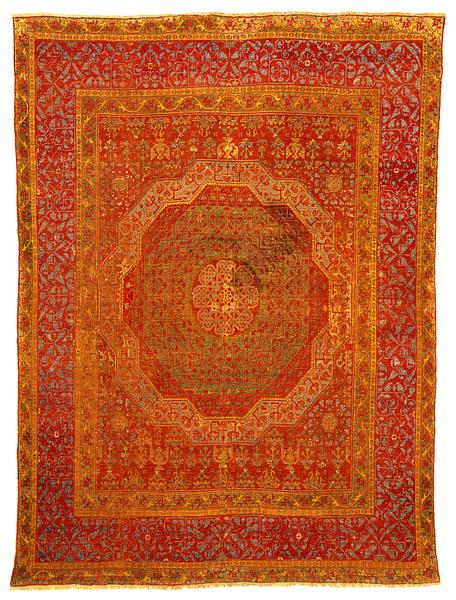Pile “Mamluk carpet,” wool
Egypt; 1st quarter of 16th century
H: 199; W: 145 cm
A palette with red, light shades of blue and green, and sometimes yellow, coupled with a clear geometric organization around a central octagon, is characteristic of “Mamluk carpets.” Typical elements are also interwoven patterns and borders that bring to mind Kufi calligraphy and stylized papyrus flowers, as seen in both the central octagon and the widest border.
The carpets were knotted in workshops in Mamluk Egypt, and their geometric structure reflects the art of the day as found in e.g. book illuminations, but also in the ceilings in the rooms whose floors they graced. The production of carpets of this kind stopped more or less at the time when the Ottomans conquered Egypt in 1517.
Inv. no. 1/1987
Published in:
Helbing, München, 28/11-1916, lot 868, pl. 118;
Helbing, München, 9/7-1918, lot 571, pl. 110;
Ulrich Schürmann: Bilderbuch für Teppichsammler, München 1960, pl. 19;
Ulrich Schürmann: Oriental carpets: an introduction, London 1966, p. 28;
Herbert Reichel: Berühmte Orient-Teppiche aus historischer Sicht, Rheinberg 1969, cat.no. 13, pp. 76-77;
Charles Grant Ellis: "Is the Mamluk carpet a Mandala? A Speculation" in Textile Museum Journal, 4:1, 1974, p. 38, fig. 12;
Kunst fra Islams Verden, 8.-18. århundrede = Art from the World of Islam. 8th-18th century, Louisiana, Humlebæk 1987, cat.no. 199;
Friedrich Spuhler: "Art from the World of Islam" in Hali, 35, 1987, p. 53;
Kjeld von Folsach: Islamic art. The David Collection, Copenhagen 1990, cat.no. 415;
Kjeld von Folsach, Torben Lundbæk and Peder Mortensen (eds.): Sultan, Shah and Great Mughal: the history and culture of the Islamic world, The National Museum, Copenhagen 1996, cat.no. 135;
Kjeld von Folsach: Art from the World of Islam in The David Collection, Copenhagen 2001, cat.no. 686;
Sheila S. Blair and Jonathan M. Bloom (eds.): Cosmophilia. Islamic Art from the David Collection, Copenhagen, McMullen Museum of Art, Boston College, Boston 2006, cat.no. 55;
Sumiyo Okumura: The influence of Turkic culture on Mamluk carpets, Istanbul 2007, cat.no. 32, pp. 150-151;
Rina Indictor: "Praise of patiens" in Hali, 150, 2007, p. 119, fig. 4;
